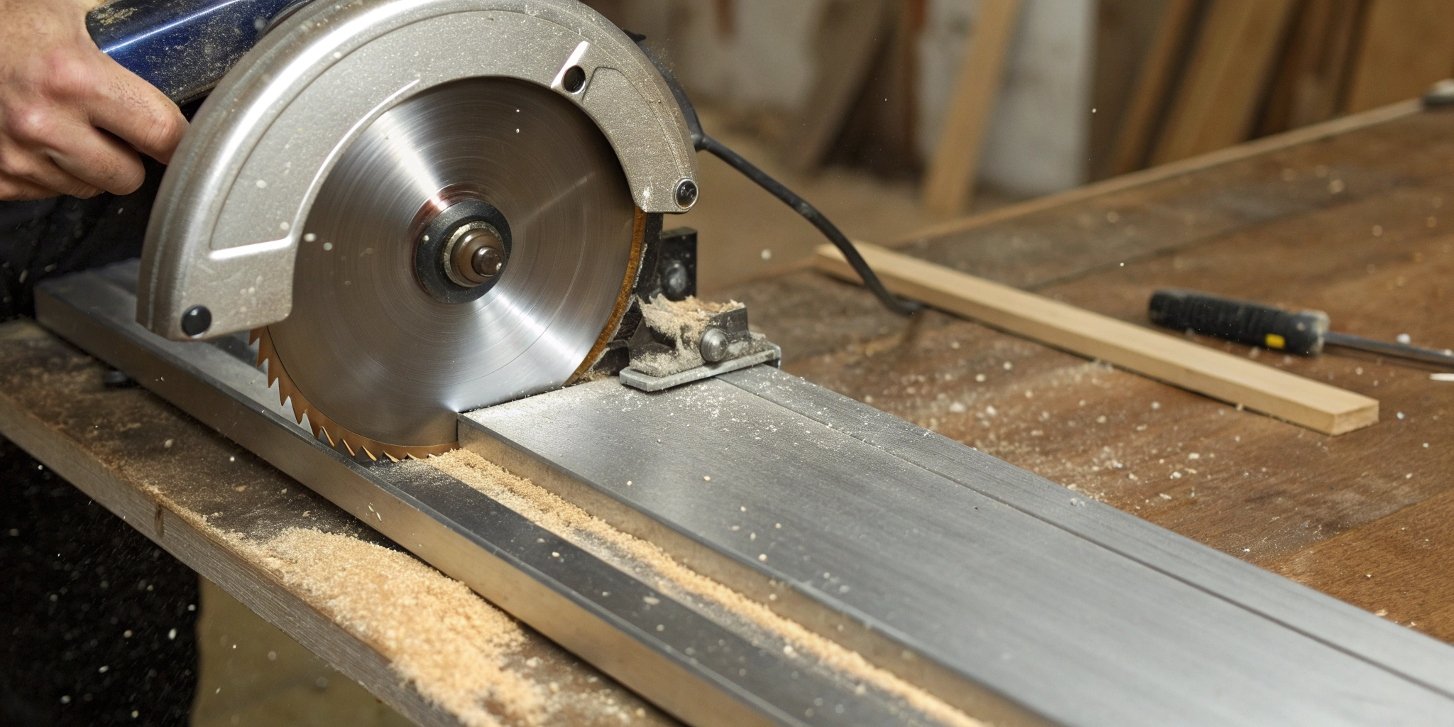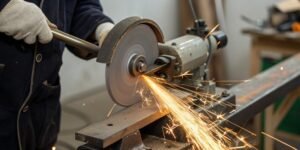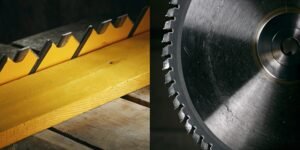
You need to cut a piece of aluminum, but you only have a wood cutting blade. This seems like it could work. But using the wrong blade can ruin your material and be a serious safety risk.
No, you should not cut aluminum with a standard wood blade. The blade’s design causes the soft aluminum to melt and clog the teeth. This leads to a messy, inaccurate cut, high heat buildup, and dangerous kickback situations. It is both ineffective and unsafe.

It can be tempting to just use the tool you have on hand. We’ve all been there, facing a deadline and thinking, "This should be close enough." But when it comes to cutting metal, especially a soft metal like aluminum, "close enough" can lead to major problems. It can damage your saw, destroy your workpiece, and even cause serious injury. Understanding why a wood blade is wrong for the job is the first step. Let’s explore what the right tools are and how to use them safely for a perfect cut every time.
What type of blade to cut aluminum?
Picking the right blade for aluminum seems complicated with so many options available. Making the wrong choice means you will waste material, work slowly, and get bad results. But knowing the key features makes choosing the correct blade very simple.
For a clean and safe cut in aluminum, you must use a blade made specifically for non-ferrous metals. You should look for a blade with a high tooth count, carbide tips, and a negative tooth angle to prevent the blade from grabbing the material.

In my nearly 30 years of manufacturing cutting tools, I’ve seen exactly what happens when the wrong blade is used. For aluminum, the details of the blade are everything. The best choice is a blade with a Triple-Chip Grind (TCG)1 tooth design. This style uses a "roughing" tooth followed by a "finishing" tooth, which clears a path and provides a smooth cut. The most important feature is the tooth angle, or rake. Wood blades have a positive rake that "hooks" into the material. For aluminum, you need a negative rake angle, usually around -5 to -10 degrees. This pushes the material down and provides a much more controlled, shearing cut, preventing the blade from climbing the workpiece. Always use a lubricant2. A simple cutting fluid3 or even wax stick cools the blade, prevents aluminum chips from welding to the teeth, and results in a much cleaner finish.
| Blade Feature | Recommendation for Aluminum | Why It Matters |
|---|---|---|
| Tooth Material | Tungsten Carbide Tipped (C3/C4 Grade) | Stays sharp longer when cutting abrasive metal. |
| Tooth Geometry | Triple-Chip Grind (TCG) | Provides a smooth finish and reduces stress on each tooth. |
| Tooth Rake | Negative Angle (-5° to -10°) | Prevents grabbing and provides a controlled, safe cut. |
| Tooth Count | High (more teeth per inch) | Results in a cleaner, smoother cut surface. |
Can I cut metal with a wood blade?
You have a project that involves cutting some metal, but you only have your trusty wood saw. Trying to use it could wreck your blade, your project, and maybe even your saw’s motor. Let’s break down exactly why this is a bad idea.
Generally, you cannot cut metal with a wood blade. Wood blades are designed for soft, fibrous material. Using them on metal creates extreme heat and friction. This will quickly dull or destroy the blade’s teeth and create a serious safety hazard.

The fundamental designs are completely different. Wood is a fiber-based material. A wood blade has large, hooked teeth with a positive rake angle designed to scoop out and remove wood fibers efficiently. Metal, on the other hand, needs to be sheared. The friction and heat generated when cutting metal are far greater than with wood. A wood blade’s teeth are not hardened to withstand this heat; they will lose their temper and become dull almost instantly. For harder metals like steel, the teeth will simply fracture and break off on contact, which can send dangerous projectiles flying. Even with very soft aluminum, the problem is not hardness but its low melting point. The heat from a wood blade will cause the aluminum to gum up the teeth, leading to a dangerous jam. Using the right blade isn’t just about getting a good cut—it’s about preventing a catastrophic failure of the tool.
| Feature | Wood Saw Blade | Metal Saw Blade |
|---|---|---|
| Tooth Angle | Positive (aggressive hook) | Negative or Neutral |
| Gullet Size | Large (for big wood chips) | Small (for fine metal shavings) |
| Heat Resistance | Low | High (Carbide or Bi-Metal) |
| Cutting Action | Scooping / Tearing | Shearing / Grinding |
Can you cut aluminum with an abrasive blade?
You have an angle grinder with a standard abrasive wheel for cutting steel. It works great on steel, so cutting soft aluminum should be easy, right? But when you try, the wheel clogs up and it seems to melt the aluminum more than it cuts.
Yes, you can cut aluminum with an abrasive blade, but it is not the best method. Abrasive blades that are designed for steel will quickly clog up with the soft aluminum. This "loading" reduces cutting power and creates a lot of heat, which melts the aluminum.

Here at our factory in Henan, we manufacture both abrasive wheels and diamond blades. We know exactly how each one works. An abrasive blade4 grinds material away, it doesn’t "cut" with teeth. The problem is that aluminum is soft and has a low melting point. As the abrasive wheel spins, the heat it generates melts the aluminum, which then smears into the pores of the wheel. This is called "loading." Once the wheel is loaded, it can no longer grind effectively. It just rubs against the workpiece, creating even more heat. While there are special abrasive wheels made with silicon carbide for non-ferrous metals, which are designed to reduce loading, they still aren’t ideal. For production work or any cut that needs to be precise and clean, a carbide-tipped blade is always the superior choice. An abrasive wheel is fine for a quick, rough cut, but it will leave a wide cut line (kerf) and a heavy burr that needs to be cleaned up later.
Can I cut aluminum with a handsaw?
You just need to make one small cut in an aluminum tube or bar for a small project. Grabbing your old wood handsaw seems like a quick solution. But it will likely just skate over the surface or bind up immediately.
You can definitely cut aluminum with a handsaw, but you must use a hacksaw with a blade made for cutting metal. A standard wood handsaw will not work. For the best results, use a hacksaw blade with a high tooth count, like 24 to 32 TPI (Teeth Per Inch).

A hacksaw is the correct manual tool for this job. Unlike a wood saw, a hacksaw uses a thin, replaceable blade held under tension in a rigid frame. The key is to choose the right blade for the thickness of the aluminum you are cutting. The rule of thumb is to have at least two to three teeth in contact with the material at all times. This prevents the teeth from snagging and breaking. For most aluminum tubes, angles, or bars, a 24 or 32 TPI blade works perfectly. For a successful cut, you must secure the aluminum firmly in a vise. This is critical for both safety and cut quality. Use light, steady pressure on the forward stroke—that’s when the cutting happens—and lift slightly on the backstroke. Using a bit of wax or oil on the blade as a lubricant will make the cut much smoother and easier, and it prevents the aluminum from gumming up the teeth.
| Aluminum Thickness | Recommended Hacksaw Blade (TPI) |
|---|---|
| Thick (>1/4" / 6mm) | 18 TPI |
| Medium (1/8" to 1/4" / 3mm to 6mm) | 24 TPI |
| Thin (<1/8" / 3mm) | 32 TPI |
Conclusion
In short, always use the right blade for the material. For aluminum, this means a dedicated non-ferrous blade to ensure safety, efficiency, and a high-quality finish on your project.
Written by
leeon
You may also be interested in:

Can you put a wood cutting blade on a grinder?
You need to cut some wood, and your angle grinder is right there. It seems like a quick an easy solution, but this is a

Can you use a diamond blade on a grinder?
Are you trying to cut hard materials like concrete but feel unsure about your tools? Using the wrong setup is dangerous and can break your

Can an angle grinder with a diamond blade cut granite?
Struggling to cut tough materials like granite? Using the wrong tool can lead to broken blades, ruined stone, and wasted budgets. The right setup, however,

Can I put a circular saw blade on a grinder?
You need to make a quick cut, and your angle grinder is right there. It’s tempting to try and fit a saw blade on it.

Is it safe to use an abrasive wheel on a cold saw?
Worried about using an abrasive wheel on your cold saw? An incompatible wheel can shatter, posing a huge risk. We will show you the correct

What circular saw blade should I buy?
Feeling lost in a sea of circular saw blades? The wrong choice can ruin expensive materials and delay your entire project. Let’s make sure you
